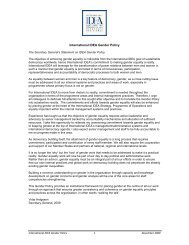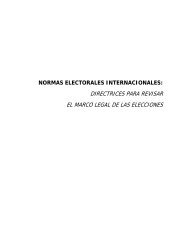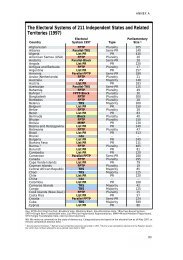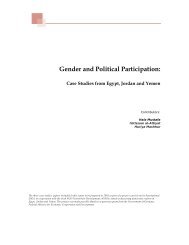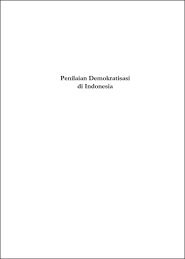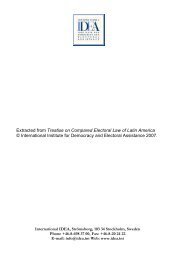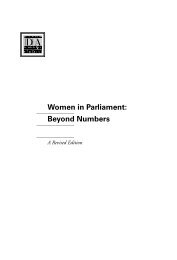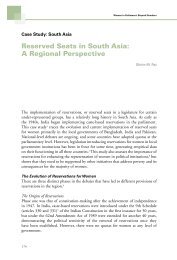The Role of State Constitutions in Protecting ... - International IDEA
The Role of State Constitutions in Protecting ... - International IDEA
The Role of State Constitutions in Protecting ... - International IDEA
You also want an ePaper? Increase the reach of your titles
YUMPU automatically turns print PDFs into web optimized ePapers that Google loves.
He stressed the need for Burmese to develop a proper understand<strong>in</strong>g <strong>of</strong> federalism<br />
– specifically, whether a federation is a union <strong>of</strong> territories or a union <strong>of</strong> ethnic<br />
segments. Secondly, he po<strong>in</strong>ted out that the ethnic nationalities and political<br />
actors <strong>in</strong> Burma will have to look at ways to accommodate the aspirations for<br />
ethnic equality, bear<strong>in</strong>g <strong>in</strong> m<strong>in</strong>d that no constituent state <strong>in</strong> Burma is ethnically<br />
homogenous. Each state is multi-ethnic. Furthermore, Chao-Tzang Yawnghe<br />
discussed the politics <strong>of</strong> ethnicity – how the concept <strong>of</strong> ethnicity has been used by<br />
successive military rulers, and by the ethnic nationalities leaders and resistance<br />
movements when articulat<strong>in</strong>g the aspirations <strong>of</strong> their respective ethnic groups.<br />
<strong>The</strong> need to argue<br />
for the democratic<br />
decentralization as the way<br />
forward for Burma<br />
He <strong>in</strong>troduced an alternative discourse, referr<strong>in</strong>g to the need to argue for<br />
democratic decentralization as the way forward for Burma, focus<strong>in</strong>g on the<br />
possibilities <strong>of</strong> government through a federal system assured by state<br />
constitutions, or on the basis <strong>of</strong> highly autonomous local governments under a<br />
union constitution.<br />
<strong>The</strong> Indian experience <strong>of</strong> accommodat<strong>in</strong>g diversity:<br />
the salad bowl approach<br />
Yogendra Yadav from the CSDS argued that even though many countries have<br />
recently become democracies <strong>in</strong> name, <strong>in</strong> practice, real democratic norms and<br />
practices are decl<strong>in</strong><strong>in</strong>g <strong>in</strong> many democracies. He stressed the importance <strong>of</strong><br />
<strong>in</strong>stitutional <strong>in</strong>novation, with different countries hav<strong>in</strong>g to develop <strong>in</strong>stitutions to<br />
adapt to their own experiences. He compared the experience to sew<strong>in</strong>g shirts <strong>in</strong><br />
different styles and sizes <strong>in</strong> accordance with the needs <strong>of</strong> a particular <strong>in</strong>dividual.<br />
He was hesitant to export lessons from India. He po<strong>in</strong>ted out that there are mixed<br />
lessons – both successes and failures. India’s experiences are encourag<strong>in</strong>g<br />
compared to some countries such as Pakistan, Sri Lanka, Yugoslavia, and the<br />
former USSR. However, cont<strong>in</strong>ued bloodshed <strong>in</strong> some <strong>of</strong> India’s states is rather<br />
discourag<strong>in</strong>g. Nevertheless, India enjoys a m<strong>in</strong>imum level <strong>of</strong> achievement <strong>in</strong> that<br />
the federation “holds-together”. India has been able to create a space <strong>in</strong> which<br />
different ethnic groups can generally work out their conflicts through non-violent<br />
means.<br />
m<strong>in</strong>ority rights are<br />
safeguarded by four<br />
ma<strong>in</strong> components<br />
• the bill <strong>of</strong> rights,<br />
• federal division <strong>of</strong> power,<br />
• a system <strong>of</strong> protections<br />
for special areas and<br />
• constitutional watchdog<br />
bodies.<br />
While Yadev elaborated on the design <strong>of</strong> the Indian constitution, he argued that<br />
the nature <strong>of</strong> the society and civilization and the nature <strong>of</strong> political practices were<br />
more important <strong>in</strong> understand<strong>in</strong>g the whole federal picture <strong>in</strong> India. While India<br />
has a federal constitution, it does not have state constitutions which safeguard<br />
ethnic equality or protection. India’s federal constitution was written <strong>in</strong> a political<br />
era when differences were viewed as a threat. However, m<strong>in</strong>ority rights are<br />
safeguarded by four ma<strong>in</strong> components <strong>of</strong> the federal constitution – 1) the bill <strong>of</strong><br />
rights, 2) federal division <strong>of</strong> power, 3) a system <strong>of</strong> protections for special areas and<br />
4) constitutional watchdog bodies. All fundamental rights are preserved <strong>in</strong> the<br />
constitution (under the bill <strong>of</strong> rights) and cannot be changed s<strong>in</strong>ce they are<br />
guaranteed by Supreme Court. <strong>The</strong>se <strong>in</strong>clude rights to equality, freedom, religious<br />
freedom, culture and education.<br />
3




